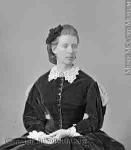Frances Anne Hopkins
Frances Anne Hopkins
Born: 1838
Death: 1919
Biography:
Frances Anne Hopkins was a British painter. She was the third of Frederick William Beechey's five children. In 1858, she married a Hudson's Bay Company official, Edward Hopkins, whose work took him to North America. Hopkins travelled alongside with him. While sailing, she was able to sketch extensively, therefore, capturing a now lost way of living – the last days of the fur trade.
Hopkins was active in the field of painting, during the 1860s and '70s. Her best-known works are several large paintings made from her sketches. She portrayed a voyageur's life in the mid-nineteenth century. Hopkins, however, remained relatively unknown until recently. At the same time, considering that, she was an artist placed in a context where gender-imposed restrictions were prevalent. In fact, Frances Anne Hopkins was dubbed as a woman who "staked out an identity based on difference: a woman in a group of men." Her works were featured at exhibitions of the Art Association of Montreal, followed by, eleven exhibitions at the Royal Academy in London.
The Hopkins’ family soon returned to England in 1870 where she lived until her death. Hopkins was an artist able to record an important aspect of Canadian history.
Frances Anne Hopkins was the daughter of Frederick William Beechey, a hydrographer and a Rear Admiral in the Royal Navy, and Charlotte Stapleton. She was born in London, England on 2 February 1838.
Hopkins was from an upper-middle-class family. There is a question whether her status had granted her access to education. She came from a family of artists and Arctic explorers. His father Sir Frederick was a water-colourist. Hopkin's aunt Anne Phyllis Beechey who was also known as Lady Beechey was a miniaturist. Her grandfather Sir William Beechey was also a portrait painter and a member of the Royal Academy of Arts. This conjecture of gaining an education, however, has not been supported by any existing records. Hopkins’ paintings and drawings, although, suggest an exemplify of trained artistry, possibly at home.
At an early age, she married Edward Martin Hopkins, a Hudson's Bay Company Secretary Governor at St. Saviour's Church, Paddington, London. He was previously married to Anne Ogden, they had three children together before she died of cholera. His husband's work would bring her on a journey that would provide subjects for her art pieces.
Frances Anne Hopkins and her husband Edward Hopkins, along with Edward’s three sons from a previous marriage, moved to Lachine, Lower Canada shortly after their marriage in 1858. The Hopkins family moved to Lachine, as Edward worked there as a secretary for Sir George Simpson, the head of the Hudson’s Bay Company’s North American operations.
Hopkins’ stay in Lower Canada differed greatly from the lives of her female counterparts in London, who, like Hopkins, were from wealthy English families. In London, these counterparts mostly led "quiet, uneventful lives largely within the limited precincts of the studio." In contrast to that, Hopkins was able to live a more adventurous life in Canada.
When she first arrived at the eastern station of the Montreal Fur Trade known as Lachine with her husband and his sons, Hopkins began sketching and painting the environment that surrounded her new home without any delay. Some of her subjects included the Hopkins family’s house and garden, which was on the shore of the St. Lawrence River, the house next door, the Lachine pier, and the nearby Dorval Island. The sketches she produced in her two years spent in Lachine were compiled into what is now known as the "Lachine Sketchbook" of 1858 to 1860, and the paintings she created in 1858 to 1859 are in the "Hopkins Album." In 1860, after the death of Sir George Simpson, Chief Facter Edward Hopkins was promoted to Superintendent of the Hudson’s Bay Company’s Montreal department, and as a result had to move his family from Lachine to the Côte-des-Neiges area of Montreal. By 1861 in Montreal, Hopkins had two sons of her own named Raymond and Wilfred, and had a daughter in 1863 named Olive. With three stepchildren and three of her own children to raise, a large home to maintain, and social obligations to tend to, she carried a large amount of responsibility, to which her husband Edward responded by hiring help to assist Hopkins with her domestic duties.
Hopkins was active in Montreal’s upper-class society. She was a prominent hostess to important English visitors who came on fur trade-related business, and had social ties with the patrons of the arts in Montreal, who at the time, were establishing art societies and building their own, individual art collections. She was involved in the social society of Lachine prior to her move to Montreal as well, which was exemplified by her presence at festivities that were held in honour of the Prince of Wales’ visit to Canada in 1860. A local newspaper wrote about the festivities shortly after they took place, stating that there were only three women in attendance, and that two of them were Hopkins and her sister, Miss Beechey. Hopkins also took the opportunity to produce some sketches during the festivities, which she later developed into large watercolours at the request of the Prince of Wales (later known as King Edward VII of the United Kingdom) for hanging at Windsor Castle.
More...
Wikipedia link: Click Here







